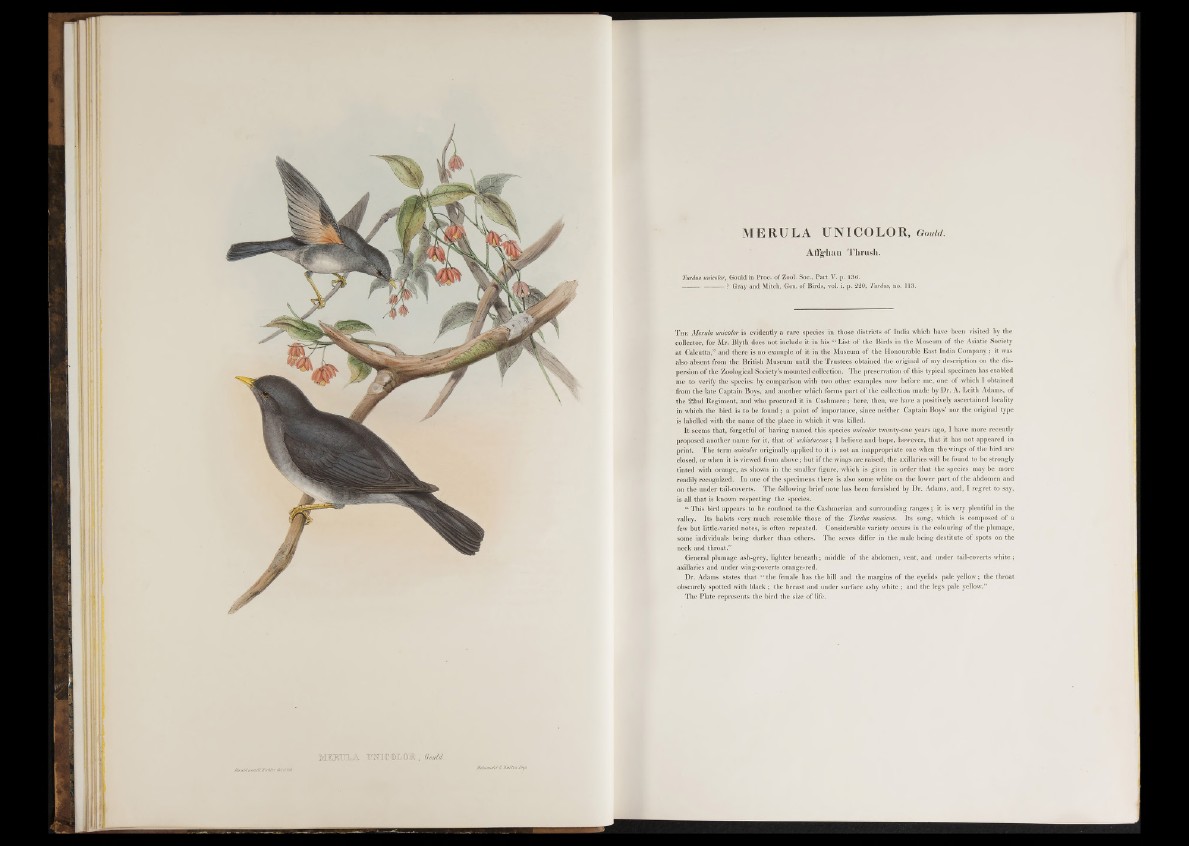
MEMTJbA n C K A K | G°M.
cuMandUCHiMer dttUM
MERULA UNICOLOR, Gould.
Affg'han Tbrush.
Turdus unicolor, Gould in Proc. of Zool. Soc., Part V. p. 136.
------------.---------? Gray and Mitch. Gen. of Birds, vol. i. p. 220, Turdus, no. 113.
T h e Merula unicolor is evidently a rare species in those districts o f India which have been visited by the
collector, for Mr. Blyth does not include it in his “ List o f the Birds in the Museum o f the Asiatic Society
at Calcutta,” and there is no example o f it in the Museum o f the Honourable East India Company; it was
also absent from the British Museum until the Trustees obtained the original o f my description on the dispersion
o f the Zoological Society’s mounted collection. The preservation o f this typical specimen has enabled
me to verify the species by comparison with two other examples now before me, one o f which I obtained
from the late Captain Boys, and another which forms part o f the collection made by D r. A. Leith Adams, of
the 22nd Regiment, and who procured it in Cashmere; here, then, we have a positively ascertained locality
in which the bird is to be fou n d ; a point o f importance, since neither Captain Boys’ nor the original type
is labelled with the name o f the place in which it was killed.
It seems that, forgetful o f having named this species unicolor twenty-one years ago, I have more recently
proposed another name for it, that o f schistaceus; I believe and hope, however, that it has not appeared in
print. The term unicolor originally applied to it is not an inappropriate one when the wings o f the bird are
closed, or when it is viewed from above; but if the wings are raised, the axillaries will be found to be strongly
tinted with orange, as shown in the smaller figure, which is given in order that the species may be more
readily recognized. In one o f the specimens there is also some white on the lower part o f the abdomen and
on the under tail-coverts. The following brief note has been furnished by Dr. Adams, and, I regret to say,
is all that is known respecting the species.
“ This bird appears to be confined to the Cashmerian and surrounding ranges; it is very plentiful in the
valley. Its habits very much resemble those o f the Titrdus musicus. Its song, which is composed o f a
few but little-varied notes, is often repeated. Considerable variety occurs in the colouring o f the plumage,
some individuals being darker than others. The sexes differ in the male being destitute o f spots on the
neck and throat.”
General plumage ash-grey, lighter beneath ; middle o f the abdomen, vent, and under tail-coverts white ;
axillaries and under wing-coverts orange-red.
Dr. Adams states that “ the female has the bill and the margins o f the eyelids pale y ellow ; the throat
obscurely spotted with black ; the breast and under surface ashy white ; and the legs pale yellow.”
The Plate represents the bird the size o f life.